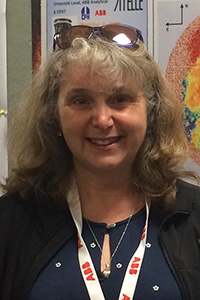Personal information
Nicole St-Louis
 Département de physique Université de Montréal C.P. 6128, Succursale Centre-Ville Montréal, QC Canada H3C 3J7 Room Campus MIL, B-3415 Phone: 514-343-6932 Fax: 514-343-2071 Email: stlouis@astro.umontreal.ca Web: https://stlou31.wixsite.com/nicolest-louis |
Research field: Wind structure of massive stars; interaction with interstellar medium; spectrocopy.
Description of the research project:
The most decisive factor in the life of a star is its mass. The most massive stars live only a few million years but still have a strong impact on their surrounding interstellar environment (ISM). These hot, luminous stars form deeply in the molecular clouds and, even before they are completely formed, develop a strong wind that persists in all their evolutionary phases. Through these flows, they chemically enrich the gas and transfer a large amount of energy and momentum to it. This leaves a rich trail of information in the ISM, in the form of ionized nebulae or gas bubbles, which inform us about the evolutionary phases that the star went through before ending its life in the form of a supernova explosion. Therefore, the winds of massive stars play a key role in the evolution of gas, dust and ultimately the stellar populations forming the galaxies.
Nicole St-Louis' research focuses on Wolf-Rayet stars (WR), stars that burn helium in their core after having exhausted hydrogen, and more particularly on large-scale structures found in the wind of about 20% of these stars, called co-rotation interacting regions (CIRs). The latter are formed when a disturbance at the base of the wind generates a flow with a speed different from that of the ambient wind which, when the star rotates, collides with the latter thus creating areas of spiral shape having higher and lower densities than the surrounding environment. The source of the disturbance is still unknown but magnetic fields and pulsations are viable candidates. Very little is known about these physical processes for massive stars, and especially for WR stars, because their surface is deeply buried under the dense wind and greatly complicates their study. The main objective is to characterize the properties of the CIRs and establish links with the stars' physical parameters to understand the origin of the disturbances that produce them.
Nicole St-Louis also uses the Fourier transform imager, SITELLE, installed on the Canada-France-Hawaii telescope to observe with unprecedented spatial and spectral resolution the circumstellar medium of a sample of massive stars in various evolutionary phases. This state-of-the-art instrument allows us to characterize the material lost by the star during its lifetime, such as heavy element enrichment, asymmetries and kinematics, as well as its density and temperature structures. By comparing these observations with predictions based on theoretical models, we can study the details of the evolutionary sequence of massive stars, from their formation to the phase that immediately precedes the supernova explosion, a sequence where many aspects still elude us today.
List of graduate students:
Cyril Dumontier (M.Sc.), Luca Fabiani (Ph.D.), Guillaume Lenoir-Craig (Ph.D.), Sylvain Raaijmakers (M.Sc.), Rémi Sincennes (M.Sc.)


 CRAQ
CRAQ